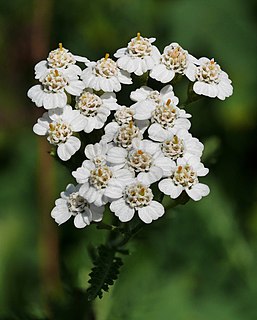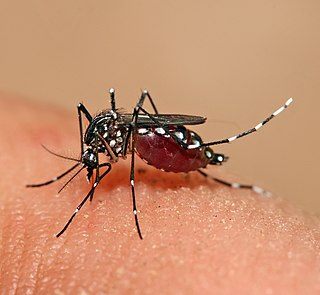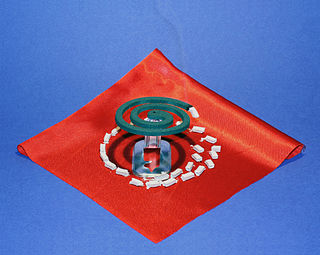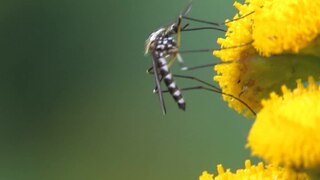
Achillea millefolium, commonly known as yarrow or common yarrow, is a flowering plant in the family Asteraceae. It is native to temperate regions of the Northern Hemisphere in Asia and Europe and North America. It has been introduced as a feed for livestock in New Zealand and Australia, where it is a common weed of both wet and dry areas, such as roadsides, meadows, fields and coastal places.

Achillea is a group of flowering plants in the family Asteraceae, known colloquially as yarrows. They were described as a genus by Linnaeus in 1753.

Aedes albopictus, from the mosquito (Culicidae) family, also known as (Asian) tiger mosquito or forest mosquito, is a mosquito native to the tropical and subtropical areas of Southeast Asia; however, in the past few decades, this species has spread to many countries through the transport of goods and international travel. It is characterized by the white bands on its legs and body.

Aedes is a genus of mosquitoes originally found in tropical and subtropical zones, but now found on all continents except Antarctica. Some species have been spread by human activity: Aedes albopictus, a particularly invasive species, was recently spread to the New World, including the United States, by the used-tire trade.
La Crosse encephalitis is an encephalitis caused by an arbovirus which has a mosquito vector.

An insect repellent is a substance applied to skin, clothing, or other surfaces which discourages insects from landing or climbing on that surface. Insect repellents help prevent and control the outbreak of insect-borne diseases such as malaria, Lyme disease, dengue fever, bubonic plague, river blindness and West Nile fever. Pest animals commonly serving as vectors for disease include insects such as flea, fly, and mosquito; and the arachnid tick.
Heneicosane is a straight chain saturated hydrocarbon with formula C21H44

Aedes aegypti, the yellow fever mosquito, is a mosquito that can spread dengue fever, chikungunya, Zika fever, Mayaro and yellow fever viruses, and other disease agents. The mosquito can be recognized by white markings on its legs and a marking in the form of a lyre on the upper surface of its thorax. This mosquito originated in Africa, but is now found in tropical, subtropical and temperate regions throughout the world.
Milfoil is a common name for several plants and may refer to:

Corymbia citriodora, commonly known as lemon-scented gum or spotted gum, is a species of tall tree that is endemic to north-eastern Australia. It has smooth white to pink bark, narrow lance-shaped to curved adult leaves, flower buds in groups of three, white flowers and urn-shaped or barrel-shaped fruit.

An ovitrap is a device which consists of a dark container containing water and a substrate where mosquitoes can lay their eggs. The eggs then fall through the mesh into the water, where the larvae hatch and develop into pupas. When the adult mosquitoes emerge, they are trapped beneath the mesh and are unable to escape from the ovitrap. Ovitraps mimic the preferred breeding site for container breeding mosquitoes, including Aedes albopictus and Aedes aegypti.

Achillea nobilis, the noble yarrow, is a flowering plant in the sunflower family. It is native to Eurasia, widespread across most of Europe and also present in Turkey, the Caucasus, and Central Asia. It is reportedly present in Xinjiang Province in western China, but this is based on a single herbarium specimen collected in the 19th century. The species is widely cultivated and has become naturalized outside of its range in North America and other parts of the world.

Eupithecia millefoliata, the yarrow pug, is a moth of the family Geometridae. The species was first described by Adolph Rössler in 1866 and it can be found in Europe and Russia.
Aedes scutellaris is a mosquito found in Ambon, Aru Islands, Seram, New Guinea. It is a vector for the dengue virus.

Carapa guianensis is a species of tree in the family Meliaceae, also known by the common names andiroba or crabwood.
Aedes malayensis was first described in 1963 by Australian entomologist Donald Henry Colless as a subspecies of Aedes scutellaris from males collected at Pulau Hantu, Keppel Harbor, Singapore. In 1972 the subspecies was elevated to species status by Yiau-Min Huang, although the move was disputed by the original describer on biological as opposed to morphological principles.
Toxorhynchites (Toxorhynchites) splendens is a species of non-hematophagous mosquito belonging to the genus Toxorhynchites. It is widely used as a predator to control dengue mosquitoes.

The Tree Hole mosquito, a close relative to the better known Asian Tiger mosquito, is native to Europe and North Africa.
Achillea santolina, a perennial herb, is commonly found in arid environments of Iraq and Jordan, but may colonize colder and more humid climates of the northern hemisphere, such as Europe and Asia. It is a traditional plant used as an herbal remedy in many parts of Iraq and Jordan and has been used as an insecticide and repellent.

Achillea tomentosa, commonly known as woolly yarrow, is a flowering plant in the family Asteraceae. It is sometimes kept as a garden plant, and occasionally naturalizes outside its original range of dry lowland habitats of southern Europe and (possibly) western Asia. It is a recipient of the RHS's Award of Garden Merit.













